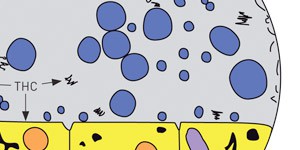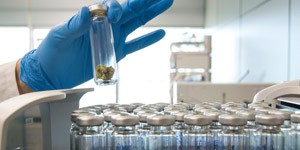By Abha Gupta

Abha received a bachelor's of science in environmental studies from Cornell University and then went on to become involved with local agriculture projects. She managed an organic vegetable farm, created an agriculture education program for youth, managed a farmers' market, and wrote articles for the Cornell Small Farms Program. She then pursued a master's of science in horticulture from Oregon State University. After receiving her master's, Abha worked for the University of Vermont Extension Services, where she managed the hemp research program, researched specialty crops, cover crops, and nutrient management, and provided outreach including conferences, workshops, and education materials for the farming community.
Abha grew up in upstate New York, lived in Oregon, and is happy to have Vermont as her current home. She enjoys hiking, skiing, swimming holes, and generally being outside in nature. She also enjoys pottery, yoga, seeing live music, and traveling.
By Geary Coogler

A graduate of Texas A&M University's School of Agriculture with a Bachelor of Science degree in Horticulture/Floriculture, Geary has more than 30 years of experience in the greenhouse industry, with the last 14 years in the Indoor Gardening industry. His experience ranges from business development to research. He currently serves as agricultural engineer fulfilling a variety of roles from advisory and regulatory to technical and writing. Geary is a member of both the International and American Society of Horticulturist and the American Horticultural Association. When not working, Geary serves his community as a volunteer firefighter, enjoys the outdoors, and dabbles with home improvement. A native of the southern reaches of the USA, Geary now makes his home in the Green Mountains of Vermont.
Plant-based medicines have been an integral part of human survival and remain an essential and revered asset to health and wellness. On a global level, the World Health Organization estimates that about 80% of the population in developing countries rely on traditional, plant-based medicines. The cannabis plant's use in medicine, religious ceremonies and recreation dates back 5000 years. Although the plant is currently viewed with controversy, scientists have worked to gain a technical understanding of the plant's biochemical and medicinal properties.
The endocannabinoid system (ECS)
Between the 1930's to 1960's, several impactful chemical compounds, called cannabinoids, within the cannabis plant were identified, including delta-9 tetrahydrocannabinol (THC), cannabidiol (CBD), cannabigerol (CBG), cannabichromene (CBC), cannabidivarin (CBDV), and tetrahydrocannabivarin (THCV). Between 1988-1992 another advancement came with identifying cannabinoid receptors in mammals, known as CB1 and CB2. Cannabinoids engage these receptors that then induce a bodily response. Once cannabinoid receptors had been discovered, it became important to establish whether mammalian tissues also produce substances to activate the receptors or if these receptors are only targeted by plant-derived and synthetic cannabinoids.
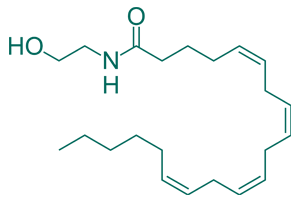
Anandamida
In 1992, the first mammalian produced cannabinoid, arachidonoylethanolamide, was discovered and named anandamide from 'ananda', the Sanskrit word for 'bliss'. Anandamide, is synthesized in areas of the brain used for memory, motivation, higher thought processes, and movement control. It also plays an important role in pain, appetite, fertility, and cancer cell mitigation. The cannabinoid protein receptors, CB1 and CB2, together with mammalian produced cannabinoids, make up what is now known as the endocannabinoid system (ECS).
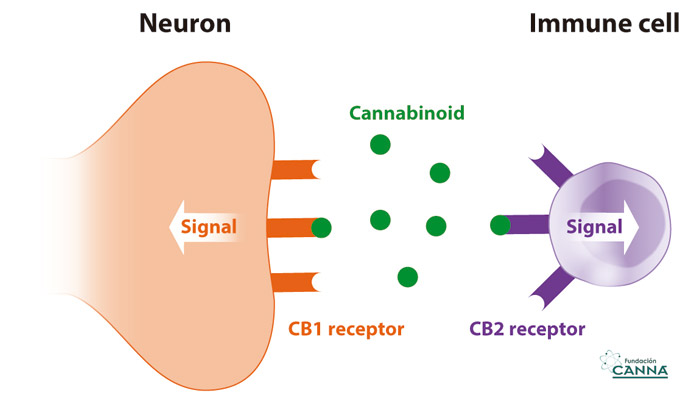
These discoveries lead to classifying the types of cannabinoids that engage with the ECS and a greater understanding of the types of responses induced from activating the CB1 and CB2 receptors. There are over 100 different cannabinoids. Exogenous cannabinoids are produced outside the mammalian body by plants or synthetically designed by chemists. Exogenous cannabinoids include phytocannabinoids, which are plant-derived and include the popularly known compounds THC and CBD. Endogenous cannabinoids, also known as endocannabinoids, are produced by the body, self-regulated, and include anandamide and other N-acylethanolamines (NAEs).
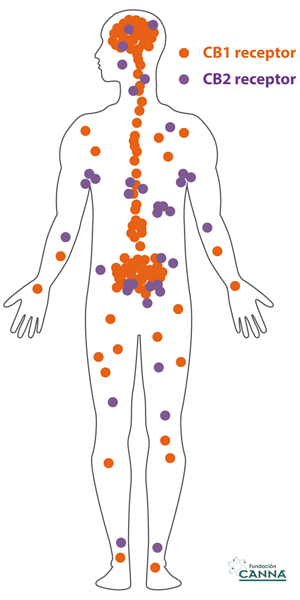
Cannabinoids engage with the two protein receptors, CB1 and CB2. These receptors are found all over the human body. CB1 receptors are expressed most densely in the central nervous system, but are also throughout the body. The CB1 receptor induces the psychoactive responses from cannabinoids, the most well-known being THC. CB2 receptors are found in the nervous system, immune system, and gastrointestinal system. Both receptors are also found in organs, glands, muscle cells, fat cells, and immune cells, accounting to be more numerous than any other receptor system. Researchers believe there is possibly a third cannabinoid receptor.
Since the ECS engages and effects the body in potentially therapeutic ways, researchers have been investigating how to target key aspects of the system to treat a wide range of diseases and pathological conditions. Some of the diseases and conditions in focus range from mood and anxiety disorders, neurodegenerative conditions such as Parkinson's, Huntington's disease, and Alzheimer's, seizures, neuropathic pain, multiple sclerosis, spinal cord injury, cancer, cardiovascular disease, stroke, hypertension, obesity/metabolic syndrome, glaucoma, reproductive disorders, and osteoporosis.
An impediment to the development of cannabinoid medications has been the socially unacceptable psychoactive properties of plant-derived or synthetic compounds that trigger the CB1 receptor. However, this problem does not arise when the treatment is combined with a CB1 receptor antagonist, which effectively turns the "off switch" on the CB1 receptor. Another possible technique for avoiding the psychological aspect of the ECS is by enhancing metabolism for endocannabinoids, since they are already produced by the human body
Plants that engage the ECS
With growing attention on utilizing the ECS for medicinal purposes, researchers have been investigating a variety of plants that engage the ECS. Many of these plants have already been used traditionally and include cocoa (Theobroma cacao), black pepper (Piper nigrum), hops (Humulus lupulus), helichrysum (Helichrysum umbraculigerum), electric daisy/spilanthes (Acmella oleracea), coneflower (Echinacea spp.), and liverwort (Radula marginata and perrottetii). These plants have been used as traditional medicines, remain a huge resource for much of the global population, and may have potential for advanced medical applications.
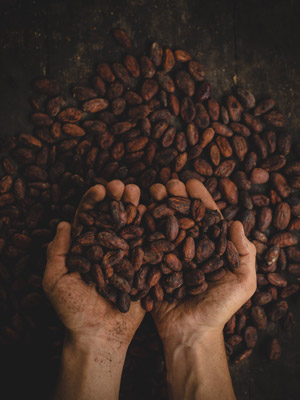
Chocolate has been revered as a mood elevator, anti-oxidant, stimulant, and aphrodisiac and was first consumed 2000-4000 years ago in Mesoamerica. Cocoa can be grown in the tropical regions around the equator, with 70% of the world's cocoa beans coming from the Ivory Coast, Ghana, Nigeria, and Cameroon.
Cocoa contains anandamide and other NAEs that bind with cannabinoid receptors directly. However, their effect seems limited, since these compounds do not survive passage through the digestive system and are generally in low quantities in chocolate products. Cocoa also contains a fatty acid that indirectly engages the ECS by preventing the breakdown of anandamide naturally produced in the brain.
This indirect mechanism for increasing anandamide levels is relatively accepted as having a bodily effect and may contribute to the hedonic properties of chocolate. Worldwide people are clearly, strongly attracted to cocoa, contributing to a $83.2 billion chocolate industry.
Beta caryophyllene: Black pepper, hops, helichrysum, and many plants
Black pepper, hops, helichrysum, oregano, cinnamon, carrots, basil, cloves, lavender, and rosemary all contain a terpene called beta-caryophyllene, which is among the most abundant plant essential oil components. Terpenes are a large and diverse class of organic compounds produced by a variety of plants. They often have a strong odor, are responsible for spice, and may serve as plant protection.
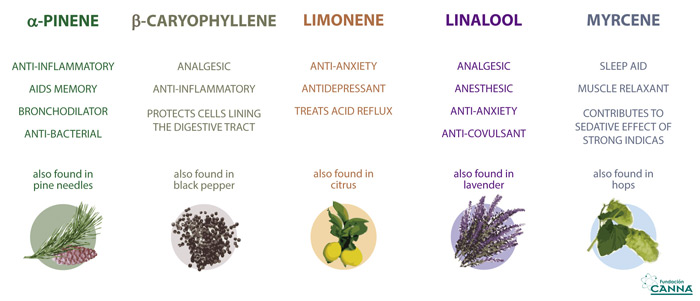
The terpene beta-caryophyllene, selectively binds to the CB2 receptor, and is also in cannabis. A study produced in 2012 showed that beta-caryophyllene specifically could be helpful with kidney dysfunction and kidney inflammation. Beta-caryophyllene is approved by the US Food and Drug Administration as a food additive and is used in cosmetics. While this terpene exists in a wide array of plants, black pepper, hops, and helichrysum have received the most attention and are the plants of focus, here.
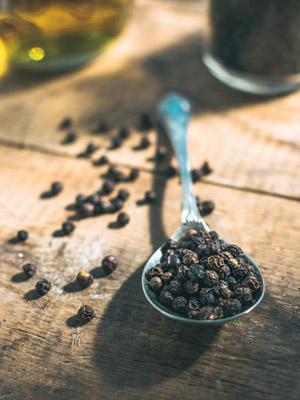
Black pepper is native to present-day Kerala, India and its use dates back 2000 years. Pepper has traditionally been used in different cultures for its medicinal properties, such as anti-rheumatic, anti-inflammatory, anti-bacterial, analgesic, and anti-fungal. Black pepper is extensively cultivated in India and elsewhere in tropical regions with Vietnam as the world's largest pepper producer, supplying 39% of the world's crop. The beta-caryophyllene in pepper is purported to reduce inflammation, aid in digestion, and ease arthritis.
Pepper also contains the fatty acid, guineensine, which prevents the uptake of endocannabinoids, effectively helping in their use for reducing inflammation and providing pain relief, as well. Pepper had been considered a luxury item for much of history, that only the very rich could afford, leading to the Dutch phrase, "pepper expensive," and the Hungarian phrase, "a price of a pepper" meaning of extraordinary value.
While common pepper is easily accessible today, its medicinal properties are still highly revered and relied upon in traditional settings.
Like pepper, hops contain beta caryophyllene, aiding with anti-inflammation and analgesic effects. The first evidence of hops was found in Egypt, dating back 2000 years. Hops were first cultivated between the years 700-1000 in Germany and gained popularity as an ingredient in beer because of its antibacterial properties combatting less desirable microorganisms and therefore improving flavor. Also, hopped beer was less likely to spoil compared to the alternative herbal blend of dandelion, burdock root, marigold, ivy, and other plants.
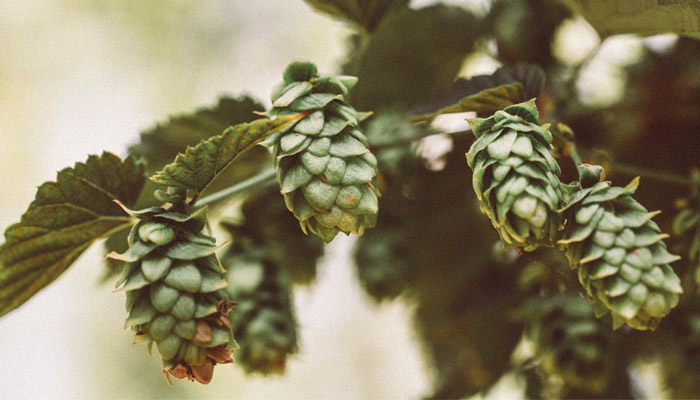
Hops prefer a temperate climate and currently the United States and Germany are its largest producers. Some hops have been bred to contain high levels of CBD. CBD has little binding affinity for cannabinoid receptors, however, it delays the reuptake of endocannabinoids, such as anandamide and adenosine. In addition, CBD activates serotonin receptors, inducing an anti-anxiety effect, activates receptors that mediate pain perception, and may have anti-cancer effects.
Traditionally hops have been used as a sleep-aid and for anti-anxiety, often in tea or tincture form, and is known as an anti-oxidant, anti-viral, and anti-inflammatory. Potential pharmaceutical uses for hops include expanding on its traditionally known medicinal properties and branching out to its use as a phytoestrogenic, anti-carcinogen, or treatment for diabetes symptoms.
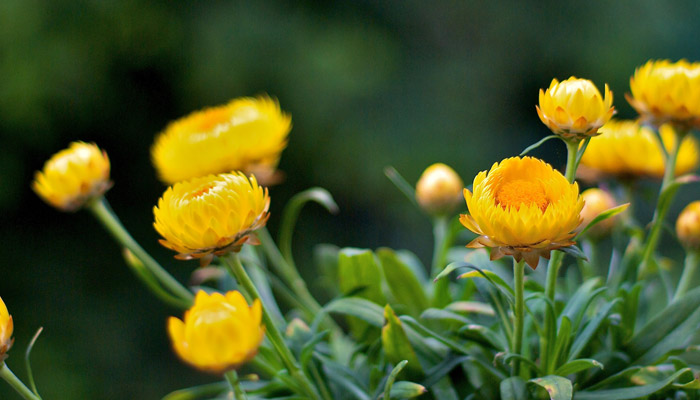
The yellow-flowered plant, helichrysum, also contains the terpene beta caryophyllene. The name helichrysum originated from Greek words, helios for sun, and chrysos, for gold, that represent the bright, yellow flowers from this genus. Helichrysum species are widespread, growing in Eurasia, Africa, and Australia. The plant has been used as a mood stabilizer, anti-depressant, anti-inflammatory, diuretic, and for healing wounds, infections, and psoriasis. The plant contains cannabigerol (CBG), which is a precursor to the active cannabinoids in cannabis, THC, CBD, and cannabichromene (CBC).
Alkylamides: Spilanthes and Echinacea
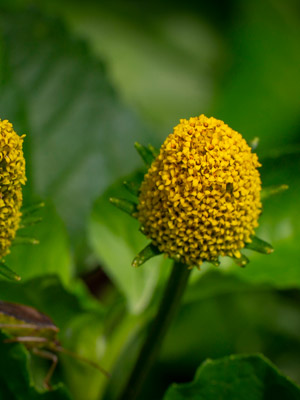
Alkylamides are compounds that are structurally similar to endocannabinoids already produced by mammals. Alkylamides are the major isolates from the plant, electric daisy, also known as spilanthes, and effectively activate the CB2 receptor.
Spilanthes is a small, flowering plant, native to Brazil, grows in a wide range of temperate environments, and has been well known for its medicinal uses. Its flowers and leaves have a pungent taste that create a tingling or numbing sensation. Spilanthes is also grown as an ornamental.
The whole plant can be used for medicinal purposes and contains antibacterial, antimalarial, and antifungal properties. Spilanthes has been used in a variety of treatments and applications, including toothaches, fever, musculoskeletal pain, join stiffness, inflammation, flu, cough, tuberculosis, skin diseases, anesthetics, digestive issues, and as an anti-wrinkle agent in beauty care.
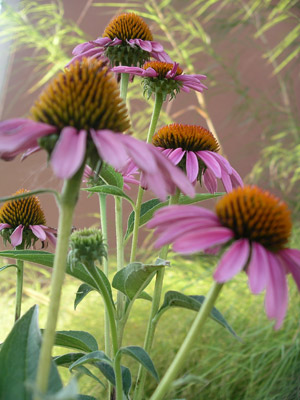
Alkylamides are found in plants from the genus Echinacea, as well. Echinacea (coneflower) herbal remedies are popularly used today, yet its history of use is relatively short. Echinacea use dates to the 1700's, when Native Americans in North America used the plant for wounds, burns, insect bites, toothache, throat infections, pain, and cramps.
More recently extracts have been used in herbal medicines for upper respiratory infections, indigestion, ADHD, chronic fatigue syndrome, migraines, chronic pain, and urinary tract infections. The alkylamides in echinacea are capable of activating the CB2 receptor and enhancing endocannabinoid transport and degradation.
As such, echinacea's cannabimimetic compounds have been suggested to have potential as an anti-inflammatory and an immune-modulatory.
The lesser known plant, liverwort, also engages the ECS by a variety of means. The Maori people of New Zealand have been using liverwort for centuries in treating liver abnormalities and digestive issues. Liverwort also grows in Japan and Costa Rica, though it is difficult to cultivate and slow-growing. The moss has also been used to treat bronchitis, inflammation, and gallbladder and bladder problems. Liverwort contains cannabigerol (CBG), perrottetinenic acid, bibenzyls, and perrottetinene (PET), which all engage with the ECS. Most notably, PET is similar in structure and activity to THC in the brains of mammals, activating both CB1 and CB2 receptors. However, the effect from PET is less potent than THC. Compared to THC, PET has a more potent anti-inflammatory effect than psychoactive, making it more attractive for medicinal as opposed to recreational purposes.
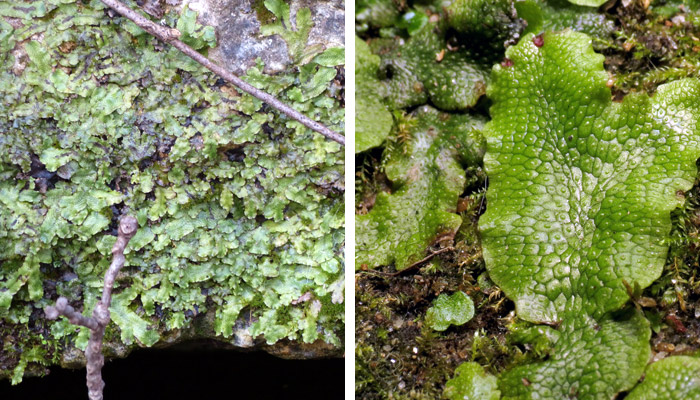
Current cannabinoid-based medicines
Cannabinoids and similar substances that engage with the ECS are being used in modern medicine applications and the potential for plant-based medicine is only growing. Currently, there are three cannabinoid-based medicines in the market that have been approved by either the European Medicines Agency or European national authorities and the US Food and Drug Administration. Marinol/Syndros (contains synthetic THC, Unimed Pharmaceuticals) and Nabilone/Cesamet (contains a synthetic cannabinoid, similar to THC, Valeant Pharmaceuticals) are used for treating nausea and vomiting from cancer drug treatment or loss of appetite from HIV/AIDS. Nabilone is also used in pain management in Canada. Epidiolex (contains CBD) is used for treating seizures associated with Lennox-Gastaut syndrome or Dravet syndrome.
The company that produced Epidiolex, Greenwhich Biosciences, also created Sativex (contains THC and CBD), which is only approved throughout Europe at this point and is used for treating spasticity due to multiple sclerosis with potential use for schizophrenia and other neurological conditions. Several more cannabinoid-related medicines are being researched for neuroprotection, anti-cancer, neuropathic pain in multiple sclerosis patients, anti-inflammation, chronic pain, memory, and weight loss by Abbott Laboratories, Indevus Pharmaceuticals, Pharmos, Cayman Chemical, Sanofi-Aventis, and Merck.
In developing these drugs, specific plant-based compounds can be challenging to protect with patents; however, it may be possible to obtain patent protection for a drug that also contains more patentable drug technology.
Cannabinoid-related medicines show a lot of promise for a wide spread of applications and scientists, pharmaceutical companies, naturopaths, and the at-home herbalist have been interested in their potential. Such plant-based medicines offer tools for accessing and benefiting from the ECS to improve health and well-being. Their application will only grow as researchers deepen their understanding of plant biochemical compounds and their effect. Plant-based medicines that purposefully engage the ECS can be incorporated in the simple, traditional, kitchen-scale realm and advanced, designer medicines, both having their place and impact in human health.
Resources
Alban, Deane. 2016. Anandamide: Putting the bliss molecule to work for your brain. Reset.me. https://reset.me/story/anandamide-putting-the-bliss-molecule-to-work-for-your-brain/
CBD from hops: Scientists create new hops strain rich in cannabidiol. October 23 2018. Royal Queen Seeds. https://www.royalqueenseeds.com/blog-cbd-from-hops-scientists-create-new-hops-strain-rich-in-cannabidiol-n1026
Chicca, A., et. al. 2009. Synergistic immunomopharmacological effects of N-alkylamides in Echinacea purpurea herbal extracts. International Journal of Immunopharmacology. 9(7-8),850-8.
Di Marzo, V., et al. 1998. Trick of treat from food endocannabinoids. Nature. 396(6712), 636-637.
Di Marzo, V., Bifulco, M. and De Petrocellis, L., 2004. The endocannabinoid system and its therapeutic exploitation. Nature reviews, Drug discovery. 3(9), 771.
Fiegl, Amanda. 2008. A brief history of chocolate. Uncover the bittersweet story of this ancient treat. Smithsonian. https://www.smithsonianmag.com/arts-culture/a-brief-history-of-chocolate-21860917/
Gertsch, J., et al. 2008. Beta-caryophyllene is a dietary cannabinoid. Proceedings of the National Academy of Sciences of the United States of America. 105(26), 9099-104.
Gertsch, J., R. Pertwee, V. Di Marzo. 2010. Phytocannabinoids beyond the Cannabis plant – do they exist?. British Journal of Pharmacology. 160(3), 523-529.
Ghassemi-Dehkordi, N., et al. 2015. Analysis of Helichrysum oligocephalum DC. essential oil. Research Journal of Pharmacognosy. 2(1), 47-52.
Glatter, Robert. October 28 2018. There's a 'legal high' you can buy online, and it isn't cannabis. Forbes. https://www.forbes.com/sites/robertglatter/2018/10/28/theres-a-legal-high-you-can-buy-online-and-it-isnt-cannabis/#79eb84ae3d80
Horváth, B., et al. 2012. β-Caryophyllene ameliorates cisplatin-induced nephrotoxicity in a cannabinoid 2 receptor-dependent manner. Free Radical Biology and Medicine. 52(8), 1325-1333.
Hughes, Calvin. October 30 2018. This moss produces cannabinoids similar to THC and others found in cannabis. Civilized. https://www.civilized.life/articles/cannabinoids-moss-thc-cannabis-liverwort/
Pacher, P., Bátkai, S. and Kunos, G. 2006. The endocannabinoid system as an emerging target of pharmacotherapy. Pharmacological Reviews. 58(3), 389-462.
Pertwee R. G. 2006. Cannabinoid pharmacology: the first 66 years. British Journal of Pharmacology. 147, S163–S171.
Pertwee, R. G. 2005. The therapeutic potential of drugs that target cannabinoid receptors or modulate the tissue levels or actions of endocannabinoids. The American Association of Pharmaceutical Scientists Journal. 7, E625-54.
Pollastro, F., et al. 2018. Reimpresión de: Amorfrutin-type phytocannabinoids from Helichrysum umbraculigerum. Fitoterapia Journal. 126, 35-39.
https://www.sciencedirect.com/science/article/pii/S0367326X18305276
Prachayasittikul, V., et al. 2013. High therapeutic potential of Spilanthes acmella: A review. Experimental and Clinical Sciences Journal. 12, 291-312.
Reynoso-Moreno, I., et al. 2017. An endocannabinoid uptake inhibitor from black pepper exerts pronounced anti-inflammatory effects in mice. Journal of Agricultural and Food Chemistry. 65(43), 9435-9442.
Russo, E.B., 2011. Taming THC: potential cannabis synergy and phytocannabinoid‐terpenoid entourage effects. British Journal of Pharmacology. 163(7), 1344-1364.
Six plants other than cannabis that are high in cancer fighting cannabinoids. 2016. Daily Health Post.
https://dailyhealthpost.com/plants-cannabinoids/
Toyota, M. et al. 2002. New bibenzyl cannabinoid from the New Zealand liverwort Radula marginata. Chemical and Pharmaceutical Bulletin. 50(10), 1390-1392.
Images
"Helichrysum" by Stephanie Kroos is licensed under CC BY-SA 2.0
"Echinacea" by reader of the pack is licensed under CC BY-ND 2.0
